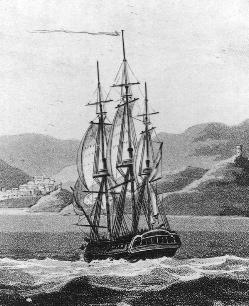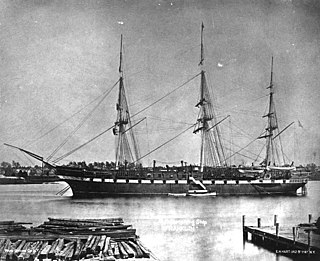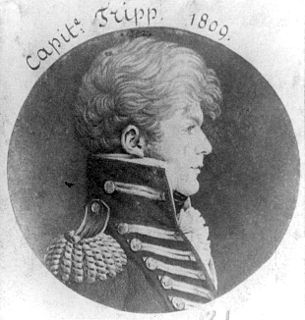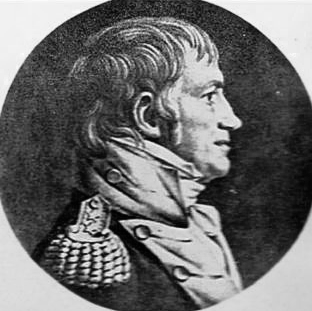
Reuben James was a boatswain's mate of the United States Navy, famous for his heroism in the First Barbary War.

The third US ship to be named Enterprise was a schooner, built by Henry Spencer at Baltimore, Maryland, in 1799. Her first commander thought that she was too lightly built and that her quarters, in particular, should be bulletproofed. Enterprise was overhauled and rebuilt several times, effectively changing from a twelve-gun schooner to a fourteen-gun topsail schooner and eventually to a brig. Enterprise saw action in the Caribbean, the Mediterranean, and the Caribbean again, capturing numerous prizes. She wrecked in July 1823.

The First Barbary War (1801–1805), also known as the Tripolitan War and the Barbary Coast War, was the first of two Barbary Wars, in which the United States and Sweden fought against the four North African states known collectively as the "Barbary States".

The Barbary Wars were a series of two wars fought by the United States, Sweden, and the Kingdom of Sicily against the Barbary states of North Africa in the early 19th century. Sweden had been at war with the Tripolitans since 1800 and was joined by the newly independent US. The First Barbary War extended from 10 May 1801 to 10 June 1805, with the Second Barbary War lasting only three days, ending on 19 June 1815.

USS Philadelphia, a 1240-ton, 36-gun sailing frigate, was the second vessel of the United States Navy to be named for the city of Philadelphia. Originally named City of Philadelphia, she was built in 1798–1799 for the United States government by residents of that city. Funding for her construction was raised by a drive that collected $100,000 in one week, in June 1798. She was designed by Josiah Fox and built by Samuel Humphreys, Nathaniel Hutton and John Delavue. Her carved work was done by William Rush of Philadelphia. She was laid down about November 14, 1798, launched on November 28, 1799, and commissioned on April 5, 1800, with Captain Stephen Decatur, Sr. in command. She was captured by Barbary pirates in Tripoli with William Bainbridge in command. Stephen Decatur led a raid that burned her down, preventing her use by the pirates.

The fourth USS Franklin was a United States Navy screw frigate. The ship was launched in 1864, partially constructed from parts of the previous Franklin (1815). Commissioned in 1867, Franklin, named after Founding Father Benjamin Franklin, served as the flagship of the European Squadron in 1867–1871. The vessel was decommissioned that year. Re-activated in 1873, the vessel joined the North Atlantic Squadron and served until 1877 when the vessel was decommissioned again and used as a receiving ship at Norfolk, Virginia. The vessel remained in this capacity until 1915 when she was stricken and sold.

The first USS Argus, originally named USS Merrimack, was a brig in the United States Navy commissioned in 1803. She enforced the Embargo Act of 1807 and fought in the First Barbary War – taking part in the blockade of Tripoli and the capture of Derna – and the War of 1812. During the latter conflict, she had been audaciously raiding British merchant shipping in British home waters for a month, when the heavier British Cruizer-class brig-sloopHMS Pelican intercepted her. After a sharp fight during which Argus's captain, Master Commandant William Henry Allen, was mortally wounded, Argus surrendered when the crew of Pelican were about to board.

USS Syren was a brig of the United States Navy built at Philadelphia in 1803. She served during the First Barbary War and the War of 1812 until the Royal Navy captured her in 1814. The British never commissioned her but apparently used her for a year or so as a lazaretto, or a prison vessel. She then disappears from records.

Nautilus was a schooner launched in 1799. The United States Navy purchased her in May 1803 and commissioned her USS Nautilus; she thus became the first ship to bear that name. She served in the First Barbary War. She was altered to a brigantine. The British captured Nautilus early in the War of 1812 and renamed her HMS Emulous. After her service with the Royal Navy, the Admiralty sold her in 1817.

The first John Adams was originally built in 1799 as a frigate for the United States Navy, converted to a corvette in 1809, and later converted back to a frigate in 1830. Named for American Founding Father and president John Adams, she fought in the Quasi-War, the First and Second Barbary Wars, the War of 1812, the Mexican–American War and the American Civil War. At the end of her career, she participated in the Union blockade of South Carolina's ports. She then participated in the raid on Combahee Ferry that Harriet Tubman, the former slave and Union operative, organized with Union colonel Montgomery. John Adams led three steam-powered gunboats up the Harbor River to Port Royal. The squadron relied on local black mariners to guide it past mines and fortifications. The squadron freed 750+ slaves and unsettled the Confederacy. Tubman was the first woman in U.S. history to plan and execute an armed expedition.

John Trippe was an officer in the United States Navy during the Quasi-War with France and the First Barbary War.

USS Richmond was a wooden steam sloop in the United States Navy during the American Civil War.

USS Vixen was a schooner in the United States Navy during the First Barbary War. Vixen was one of four vessels authorized by Congress on 28 February 1803. She was built at Baltimore, Maryland, in the spring of 1803; and launched on 25 June, Lieutenant John Smith in command.

The Mediterranean Squadron, also known as the Mediterranean Station, was part of the United States Navy in the 19th century that operated in the Mediterranean Sea. It was formed in response to the First and Second Barbary Wars. Between 1801 and 1818, the squadron was composed of a series of rotating squadrons. Later, squadrons were sent in the 1820s to the 1860s to suppress piracy, primarily in Greece and to engage in gunboat diplomacy. In 1865 the force was renamed the European Squadron.

USS Wren (DD-568) was a Fletcher-class destroyer of the United States Navy.

The Second Battle of Tripoli Harbor was a naval action that occurred during the American naval blockade which took place in Tripoli Harbor on July 14, 1804. The battle was part of the First Barbary War between forces of the United States and the forces of the Eyalet of Tripolitania.

USS Bangor (PF-16) was a United States Navy Tacoma-class frigate in commission from 1944 to 1946. Thus far, she has been the only U.S. Navy ship named for Bangor, Maine. She later served in United States Coast Guard as USCGC Bangor and in the Mexican Navy as ARM General José María Morelos and ARM Golfo de Tehuantepec.

The action of 1 August 1801 was a single-ship action of the First Barbary War fought between the American schooner USS Enterprise and the Tripolitan polacca Tripoli off the coast of modern-day Libya.

Stephen Decatur Jr. was an American naval officer and commodore. He was born on the eastern shore of Maryland in Worcester County. His father, Stephen Decatur Sr., was a commodore in the United States Navy who served during the American Revolution; he brought the younger Stephen into the world of ships and sailing early on. Shortly after attending college, Decatur followed in his father's footsteps and joined the U.S. Navy at the age of nineteen as a midshipman.

Captain John Smith was a United States Navy officer, who served during the First Barbary War and later in the War of 1812. He commanded USS Vixen, USS Syren, USS Wasp, USS Essex, USS Congress, and USS Franklin.















